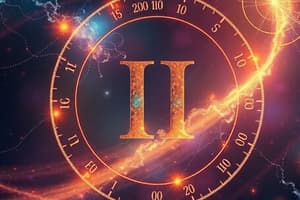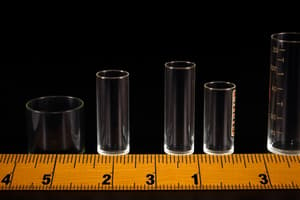Podcast
Questions and Answers
What is the primary characteristic of a base quantity?
What is the primary characteristic of a base quantity?
- It is a quantity that changes with respect to time.
- It is only used in advanced physics calculations.
- It can be derived from other physical quantities.
- It cannot be derived from any other physical quantity. (correct)
Which of the following is an example of a derived quantity?
Which of the following is an example of a derived quantity?
- Time
- Length
- Mass
- Velocity (correct)
What is the SI unit for measuring the amount of substance?
What is the SI unit for measuring the amount of substance?
- Mole (correct)
- Kelvin
- Ampere
- Kilogram
What is the correct formula for calculating the area of a rectangle, and what type of quantity does area represent?
What is the correct formula for calculating the area of a rectangle, and what type of quantity does area represent?
When converting units, which conversion converts 50 mm to Gigameters (Gm)?
When converting units, which conversion converts 50 mm to Gigameters (Gm)?
What does accuracy primarily indicate in the context of measurements?
What does accuracy primarily indicate in the context of measurements?
If a student consistently measures the length of an object to be 25.5 cm, 25.6 cm, and 25.5 cm, while the actual length is 27.0 cm, how would you describe these measurements?
If a student consistently measures the length of an object to be 25.5 cm, 25.6 cm, and 25.5 cm, while the actual length is 27.0 cm, how would you describe these measurements?
Which type of error is primarily reduced by repeating measurements and calculating the average?
Which type of error is primarily reduced by repeating measurements and calculating the average?
What is a defining characteristic of systematic errors in measurement?
What is a defining characteristic of systematic errors in measurement?
In the number 0.004020, how many significant figures are present?
In the number 0.004020, how many significant figures are present?
How many significant figures are in the measurement 40,501 kg?
How many significant figures are in the measurement 40,501 kg?
If a number does not contain decimal points, which zeros are considered significant?
If a number does not contain decimal points, which zeros are considered significant?
When adding or subtracting measurements, what determines the number of decimal places in the final answer?
When adding or subtracting measurements, what determines the number of decimal places in the final answer?
When multiplying or dividing measurements, what determines the number of significant figures in the final answer?
When multiplying or dividing measurements, what determines the number of significant figures in the final answer?
Convert 7200 mm to kilometers (km)?
Convert 7200 mm to kilometers (km)?
Convert 3 nanometers (nm) to micrometers (µm)?
Convert 3 nanometers (nm) to micrometers (µm)?
Convert 1200 micrometers (µm) to kilometers (km)?
Convert 1200 micrometers (µm) to kilometers (km)?
What is the primary purpose of unit conversion in physics?
What is the primary purpose of unit conversion in physics?
Which of the following prefixes represents a multiple of $10^{-6}$?
Which of the following prefixes represents a multiple of $10^{-6}$?
If a student measures a length as 2.5 cm using a ruler, what is the most crucial next step to ensure the measurement is properly communicated in a scientific context?
If a student measures a length as 2.5 cm using a ruler, what is the most crucial next step to ensure the measurement is properly communicated in a scientific context?
Which of the following is the correct representation of $4 \times 10^2$ with 2 significant figures?
Which of the following is the correct representation of $4 \times 10^2$ with 2 significant figures?
During an experiment, a researcher uses a faulty ammeter that consistently reads 0.15 A higher than the actual current. What type of error is most likely affecting the measurements?
During an experiment, a researcher uses a faulty ammeter that consistently reads 0.15 A higher than the actual current. What type of error is most likely affecting the measurements?
A student measures the current flowing through a circuit three times and obtains the following readings: 2.13 A, 2.14 A, and 2.12 A. If the actual current is 2.25 A, how are the measurements best described?
A student measures the current flowing through a circuit three times and obtains the following readings: 2.13 A, 2.14 A, and 2.12 A. If the actual current is 2.25 A, how are the measurements best described?
In an experiment to measure the acceleration due to gravity, a group of students uses a photogate timer that records time intervals with high precision. However, they forget to account for air resistance, which slightly reduces the measured acceleration. What type of error impacts the result?
In an experiment to measure the acceleration due to gravity, a group of students uses a photogate timer that records time intervals with high precision. However, they forget to account for air resistance, which slightly reduces the measured acceleration. What type of error impacts the result?
A student needs to measure the diameter of a tennis ball using a ruler. To minimize parallax error, what should the student do?
A student needs to measure the diameter of a tennis ball using a ruler. To minimize parallax error, what should the student do?
A researcher is measuring the length of a table and records it as 1.50 meters. Later, another person measures the same table using a different measuring tape and records it as 1.5 meters. Which measurement shows greater precision?
A researcher is measuring the length of a table and records it as 1.50 meters. Later, another person measures the same table using a different measuring tape and records it as 1.5 meters. Which measurement shows greater precision?
How should the result of the subtraction 15.67 m – 2.1 m be reported, considering significant figures?
How should the result of the subtraction 15.67 m – 2.1 m be reported, considering significant figures?
A rectangular garden has a length of 12.5 meters and a width of 8.3 meters. What is the area of the garden, reported with the correct number of significant figures?
A rectangular garden has a length of 12.5 meters and a width of 8.3 meters. What is the area of the garden, reported with the correct number of significant figures?
What distinguishes a 'physical quantity' from other types of quantities?
What distinguishes a 'physical quantity' from other types of quantities?
Which of the following is NOT a base quantity in the SI system?
Which of the following is NOT a base quantity in the SI system?
Determine how many significant figures are present in the measurement 2.30 × 10^–4 km.
Determine how many significant figures are present in the measurement 2.30 × 10^–4 km.
What are the implications of a measurement having high precision but low accuracy?
What are the implications of a measurement having high precision but low accuracy?
Under what circumstances are zeros located between non-zero digits considered significant?
Under what circumstances are zeros located between non-zero digits considered significant?
Flashcards
SI system (Standard Units)
SI system (Standard Units)
A consistent system of units used globally for measurement, also known as the metric system.
Physical Quantity
Physical Quantity
A quantity that can be measured using a measuring instrument.
Base Quantity
Base Quantity
A fundamental quantity that cannot be derived from other physical quantities.
Derived Quantity
Derived Quantity
Signup and view all the flashcards
Accuracy
Accuracy
Signup and view all the flashcards
Precision
Precision
Signup and view all the flashcards
Human Error
Human Error
Signup and view all the flashcards
Method Error
Method Error
Signup and view all the flashcards
Parallax Error
Parallax Error
Signup and view all the flashcards
Instrumental Error
Instrumental Error
Signup and view all the flashcards
Systematic Error
Systematic Error
Signup and view all the flashcards
Random Error
Random Error
Signup and view all the flashcards
Significant Figures
Significant Figures
Signup and view all the flashcards
Unit Conversion
Unit Conversion
Signup and view all the flashcards
Significant figures rule
Significant figures rule
Signup and view all the flashcards
Significant figures rule
Significant figures rule
Signup and view all the flashcards
Significant figures rule
Significant figures rule
Signup and view all the flashcards
Significant figures rule
Significant figures rule
Signup and view all the flashcards
Adding/Subtracting Sig Figs
Adding/Subtracting Sig Figs
Signup and view all the flashcards
Multiplying/Dividing Sig Figs
Multiplying/Dividing Sig Figs
Signup and view all the flashcards
Study Notes
- Chapter 1 is about the Measurement of Physics.
- Syllabus includes measurements of physics, kinematics and dynamics, work energy and power, fluid mechanics, concept of heat and temperature, electricity and magnetism, geometrical optics and physical optics, nucleus and photoelectric effect, sound, and medical physics.
- Final Exam is worth 50% and is made up of Part A with 20 MCQs and Part B with 6 structured questions.
- Continuous Assessment is worth 50% and is made up of lab practical for 10%, quiz 1 for 5%, quiz 2 for 5%, CA 1 (week 6) for 10% including Part A with 10 MCQs and Part B with 4 structured questions, CA 2 (week 12) for 10% including Part A with 10 MCQs and Part B with 4 structured questions, and poster presentations for 10%.
Chapter Outline
- Standard Units
- Physical Quantities
- Accuracy and Precision
- Unit Conversion
- Significant figures
Standard Units
- The SI system is also called the metric system, and is used around the world
- Length SI unit is the meter (m)
- Mass SI unit is the kilogram (kg)
- Time SI unit is the second (s)
- Temperature SI unit is the kelvin (K)
- Electric current SI unit is the ampere (A)
- Amount of substance SI unit is the mole (mol)
Physical Quantities and SI Units
- Physical quantity is defined as a quantity that can be measured using a measuring instrument
- Unit is defined as a standard size of measurement of a physical quantity
- Physical quantity can be categorized into two types: base quantity and derived quantity
Base Quantity
- Base quantity is defined as a quantity that cannot be derived from any other physical quantity.
- Length SI unit is the meter (m)
- Mass SI unit is the kilogram (kg)
- Time SI unit is the second (s)
- Temperature SI unit is the kelvin (K)
- Electric current SI unit is the ampere (A)
- Amount of substance SI unit is the mole (mol)
Derived Quantity
- Derived quantity is defined as a quantity that is obtained from the combination of base quantities.
- Velocity = s/t, measured in m s⁻¹
- Frequency = 1/T, measured in s⁻¹ or Hz (hertz)
- Acceleration = v/t, measured in m s⁻²
- Pressure = F/A, measured in N m⁻² or Pa (pascal)
- Momentum = m x v, measured in kg m s⁻¹
- Force = m x a, measured in kg m s² or N(newton)
- Work = F x s, measured in kg m² s⁻² or J(joule)
- Power = W/t, measured in Js⁻¹ or W (watt)
Accuracy and Precision
- Accuracy measures how close a measurement is to the true value of the quantity being measured.
- Precision measures how close a series of measurements are to one another, and how exact a measurement is.
Sources of Error
- Human error includes mistakes made in reading an instrument or recording the results.
- Method Error happens when measurements are taken using different methods
- Parallax error is an overestimate due to the improper viewing of a measuring device.
- Instrumental error means improperly displayed measurements due to poorly calibrated devices.
Errors
- Systematic error is caused by the equipment used.
- Random error is caused by environmental factors.
- Zero errors are systematic errors.
- Parallax error is a random error.
Precision and Significant Figures
- Significant figures describe the precision of a measuring device.
Guidelines for Using Significant Figures
- Any digit that is not zero is significant, e.g., 845 cm has 3 SFs.
- Zeros between nonzero digits are significant, e.g., 40 501 kg contains 5 SFs.
- Zeros to the left of the first nonzero digit are not significant, e.g., 0.008 L contains 1 SF.
- If the number is ≥ 1, then all the zeros written to the right of the decimal point are significant, e.g., 2.00 mg has 3 SFs.
Studying That Suits You
Use AI to generate personalized quizzes and flashcards to suit your learning preferences.




